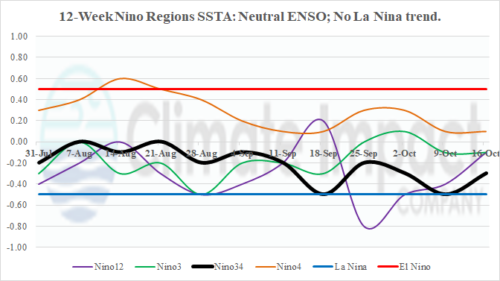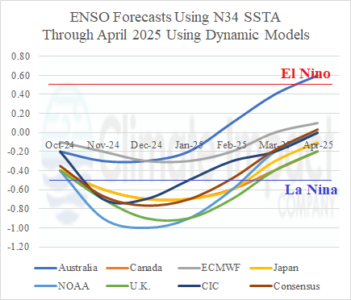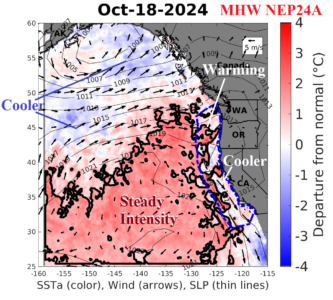Latest News
10/21/2024, 2:13 pm EDT
The Nino SSTA regions are locked-in on neutral phase. There is no shift in trend to indicate La Nina onset. In the subsurface, the anomalous cool water to fuel La Nina is diminishing. Most of the cool water is between 100 and 150 meters with about half the strength of several weeks ago.
10/21/2024, 8:28 am EDT
An ALERT is posted for tropical cyclone development late in October for the central/east Caribbean Sea. A Halloween tropical cyclone is likely in this region. The next storm name is Patty. Early projections indicate a significant storm drifting north or northeast possibly affecting Hispaniola and/or Puerto Rico.
10/16/2024, 2:31 pm EDT
Marine heat waves continue to produce significant influence on where semi-permanent high-pressure areas form alongside their compensating low-pressure areas. Many MHW’s are ongoing in the northern hemisphere, the strongest east of Japan. Regenerating MHW’s are likely during the southern hemisphere summer in the subtropical/middle latitude oceans. The extensive warming of the ocean caused by MHW’s is likely suppressing La Nina onset.
10/15/2024, 7:52 pm EDT
Meteorological summer brings suppressed heat risk across the western third of the continent while central and eastern Australia are hotter than normal. The precipitation regime is quite wet in the Northwest, near normal on the South Coast, and drier than normal from central New South Wales across much of Queensland. Summer drought risk during summer 2024-25 increases in Queensland to Northern New South Wales.
10/14/2024, 4:33 am EDT
Climate diagnostics reveal marginal support for weak La Nina ahead. Dynamic and analog forecasts maintain weak La Nina for late 2024 likely not lasting long ending as meteorological winter 2024-25 in the northern hemisphere closes. The low confidence ENSO phase forecast for the remainder of 2025 is steady neutral ENSO phase. Strong ENSO events are not likely into 2026.
Climate Impact Company Chart of the Day
Negative Pacific North America Index COULD Bring Great Plains Rain
On and off Great Plains wet weather for late October/early November is reliant on evolution of a negative phase Pacific North America (-PNA) index pattern. If -PNA develops, an upper trough cools the West and forces southerly flow out of the western Gulf of Mexico to interact with cold fronts in the Great Plains and cause rainfall.
Climate Impact Company Climate Diagnostics
Record Strength and Length of -PDO Regime Despite Warm Northeast Pacific!
Another hotter than normal summer and early autumn in California thanks in large part to the emergence of Marine Heat Wave NEP24A which started last April offshore and spread into the U.S. West Coast and intensified during the summer season. As usual, the presence of the MHW helped amplify an upper-level high-pressure ridge to cause the hot summer. One fascinating aspect of MHW24A is the persistent and strengthening cool phase of the Pacific decadal oscillation (PDO), normally present when the Northeast Pacific Ocean surface is cooler than normal.








